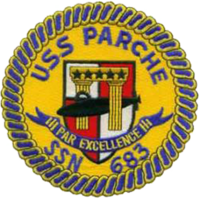USS Parche (SSN-683)

USS Parche (SSN-683) off Pearl Harbor, Hawaii, sometime prior to October 1985. The structure on the after part of her casing is a permanently attached swimmer lock-out chamber, although described under its cover story as Deep Submergence Rescue Vehicle. Her ship's insignia is at lower right.
|
|
| History | |
|---|---|
| Name: | USS Parche (SSN-683) |
| Namesake: | The parche, a type of butterfly fish |
| Ordered: | 25 June 1968 |
| Builder: | Ingalls Shipbuilding, Pascagoula, Mississippi |
| Laid down: | 10 December 1970 |
| Launched: | 13 January 1973 |
| Sponsored by: | Mrs. Philip A. Beshany |
| Commissioned: | 17 August 1974 |
| Decommissioned: | 19 October 2004 |
| Struck: | 18 July 2005 |
| Motto: | Par Excellence |
| Honors and awards: |
|
| Fate: | Scrapping via Ship and Submarine Recycling Program completed 30 November 2006 |
| Badge: |  |
| General characteristics | |
| Class and type: | Sturgeon-class attack submarine |
| Displacement: |
|
| Length: |
|
| Beam: | 31 ft 8 in (9.65 m) |
| Draft: | 28 ft 8 in (8.74 m) |
| Installed power: | 15,000 shaft horsepower (11.2 megawatts) |
| Propulsion: | One S5W nuclear reactor, two steam turbines, one screw |
| Speed: |
|
| Test depth: |
|
| Armament: | 4 × 21-inch (533 mm) torpedo tubes |
USS Parche (SSN-683), a Sturgeon-class submarine, was the second ship of the United States Navy to be named for the parche /ˌpɑːrˈtʃeɪ/, a small, coral reef butterfly fish. Parche was launched on 13 January 1973, sponsored by Mrs. Philip A. Beshany, and commissioned on 17 August 1974 with Commander Richard N. Charles in command.
Attributed as being a key resource of the National Underwater Reconnaissance Office, Parche is said to be "the most highly decorated vessel in U.S. history."
Parche served as a unit of the United States Atlantic Fleet Submarine Force from 1974 until 1976, before transferring to the United States Pacific Fleet in October 1976. Once arriving at her new home port at Mare Island Naval Shipyard in Vallejo, California, Parche received ocean engineering modifications. Parche deployed on a shakedown training cruise in August and September 1978.
In the book Blind Man's Bluff, it is claimed that Parche successfully tapped into Soviet underwater military communication cables in the Sea of Okhotsk in 1979 as part of Operation Ivy Bells.
...
Wikipedia
